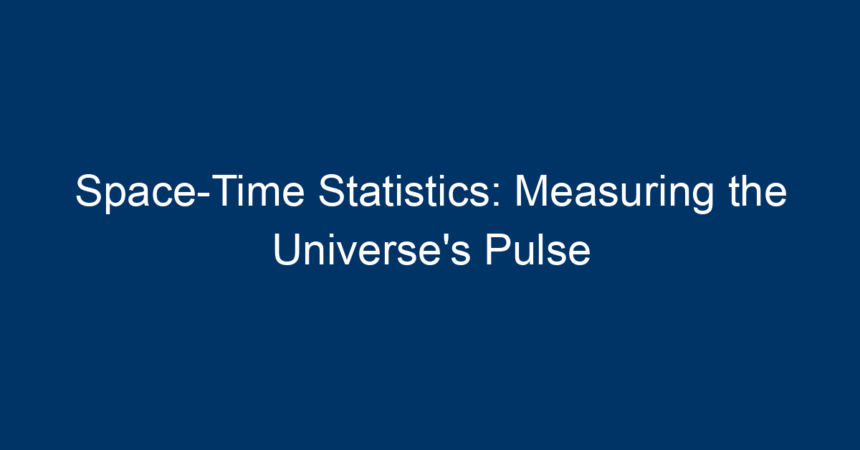The universe is a grand tapestry woven together with mysterious threads of physics, mathematics, and time itself. Among the many tools scientists employ to understand this cosmic fabric, space-time statistics stands out as a crucial methodology. This article delves into the intricate world of space-time statistics, exploring its definition, significance, applications, and future prospects.
What Are Space-Time Statistics?
Space-time statistics refers to the statistical methods employed to analyze data that varies across both space and time. In essence, it combines the dimensions of time and space, allowing scientists to extract meaningful insights about cosmic phenomena. This interdisciplinary field integrates principles from physics, mathematics, and data science, making it an essential tool for researchers examining everything from cosmic radiation to the distribution of galaxies.
The Foundation of Space-Time Statistics
At its core, space-time statistics utilizes principles of statistical analysis applied to spatial and temporal dimensions. Data can represent a multitude of phenomena, such as the movement of celestial bodies, fluctuations in cosmic microwave background radiation, or the clustering of galaxies. By using sophisticated statistical models, researchers can detect patterns, make predictions, and draw conclusions about the underlying processes driving these phenomena.
The Importance of Space-Time Statistics
Why should we care about space-time statistics? The answer lies in its potential to provide insights into the very nature of our universe. By measuring the "pulse" of the universe, scientists can gain a better understanding of fundamental questions about its origin, structure, and fate.
-
Understanding Cosmic Evolution: Space-time statistics plays a vital role in understanding how galaxies and clusters evolve over time. By analyzing the distribution patterns, scientists can infer the influences shaping them, such as dark matter and cosmic inflation.
-
Exploring Quantum Phenomena: Quantum mechanics introduces a host of uncertainties that require rigorous statistical methods for interpretation. Space-time statistics helps physicists navigate these complexities, enabling them to test theories and model predictions related to quantum behavior.
- Insights into Astrophysical Events: Terrestrial and cosmic events (like supernovae or gamma-ray bursts) alter the landscape of the universe. Through space-time statistics, researchers can quantify these events’ impacts, offering insights into their physical processes.
Techniques Used in Space-Time Statistics
To effectively measure and understand phenomena in the universe, statisticians and physicists employ a variety of analytical techniques:
1. Spatial Autocorrelation
Spatial autocorrelation is a technique used to assess the correlation of a variable with itself across different locations. This method helps scientists discern patterns in the distribution of celestial objects—whether they are clustered, dispersed, or randomly distributed.
2. Time Series Analysis
Time series analysis is critical for understanding how data points change over time. This technique is particularly useful for studying phenomena such as star formation rates or cosmic microwave background variations. By analyzing trends and seasonal patterns, scientists can identify underlying mechanisms driving these changes.
3. Gaussian Processes
Gaussian processes are powerful tools that allow statisticians to make inferences about unknown functions. In the context of space-time statistics, they can be used to model uncertainties in observational data, helping researchers better understand the relationships between different cosmic variables.
Applications of Space-Time Statistics
Space-time statistics finds applications across various domains of astrophysics, cosmology, and even earth sciences. Here are some notable areas where it has proven invaluable:
1. Cosmological Simulations
Cosmological simulations aim to replicate the evolution of the universe using mathematical models. Space-time statistics helps in refining these simulations by providing statistical validation of results and guiding future simulations based on observational data.
2. Detecting Exoplanets
The search for exoplanets—planets outside our solar system—has been revolutionized by space-time statistics. By analyzing periodic variations in light from stars, scientists can detect the presence of planets, assess their orbits, and even infer their potential habitability.
3. Gravitational Waves
With the advent of gravitational wave astronomy, space-time statistics has taken on new significance. Events like black hole mergers create ripples in space-time detectable on Earth. By applying statistical models to the data from these events, researchers can learn about the properties of black holes and the fundamental structure of space-time.
Case Studies in Space-Time Statistics
Examining specific case studies highlights the transformative power of space-time statistics in practical settings.
1. The Sloan Digital Sky Survey (SDSS)
The SDSS is one of the most ambitious astronomical surveys ever undertaken. By utilizing space-time statistics, researchers have mapped the distribution of millions of galaxies across vast regions. This extensive dataset has enabled groundbreaking insights into galaxy formation and the role of dark energy.
2. Observations from the Planck Satellite
The European Space Agency’s Planck satellite measured the cosmic microwave background radiation, a remnant of the Big Bang. By applying space-time statistical methods, scientists were able to analyze this radiation’s temperature fluctuations, contributing significantly to our understanding of the universe’s early state.
Future Perspectives in Space-Time Statistics
The field of space-time statistics is continuously evolving. With advances in technology and big data analytics, future prospects are promising:
-
Machine Learning and AI: Incorporating machine learning algorithms can enhance predictive capabilities and pattern recognition within large datasets, making space-time statistics even more robust.
-
Interdisciplinary Collaboration: As various fields converge—such as astrophysics, computer science, and statistics—collaborative efforts will propel space-time statistics to new heights, enabling deeper insights into cosmic phenomena.
- Enhanced Simulation Models: Developing more sophisticated simulation models that incorporate real-time data will help scientists better understand the dynamics of the universe, moving beyond theoretical constructs.
Conclusion: The Pulse of the Universe
Space-time statistics serves as a critical tool for unlocking the mysteries of the universe. By measuring its pulse, scientists can derive insights into the fundamental nature of space and time, contributing not only to our understanding of the cosmos but also enriching our knowledge across various scientific disciplines.
As the universe continually evolves, so too does the methodology we employ to study it. By embracing innovative techniques and fostering interdisciplinary collaboration, the field of space-time statistics is poised to reveal even more of the universe’s secrets.
For aspiring researchers and enthusiasts alike, delving into the world of space-time statistics offers an exciting gateway to understanding our place in the cosmos and the intricate dance of creation and decay that unfolds over the vastness of space and time.




